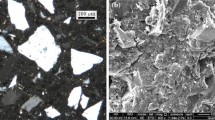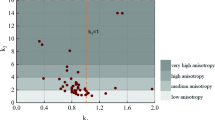Abstract
A large number of experimental investigations on anisotropic behavior of transversely isotropic rock have been conducted recently, and the strength and deformation anisotropy and macroscopic failure behavior and failure mechanism were studied in detail. However, the internal variation and microscopic failure mechanism of transversely isotropic rock have been rarely determined by laboratory tests, and few studies have reported these types of results. This paper presents an investigation of particle flow code in 2 dimensions (PFC2D) simulation on transversely isotropic rock under different confining pressures based on laboratory experiments. The transversely isotropic PFC2D model is established by the bonded-particle model (BPM) and the smooth-joint model (SJ) to represent the layer materials and weak planes, respectively. To reflect the experimental specimens accurately, BPM and SJ microparameters are calibrated first. The simulated strength and deformation anisotropy of transversely isotropic rock under different confining pressures are all consistent with the experimental specimens and can reflect the macroscopic failure behavior and failure mechanism of experimental specimens very well. On a microscopic level, the internal variation and microscopic failure mechanisms of transversely isotropic rock are studied in detail, and four types of microcracks, namely PB tensile cracks and PB shear cracks, which exist in the layer materials, and SJ tensile cracks and SJ shear cracks, which exist in the weak planes, are recorded and counted to reveal the microscopic failure mechanisms of transversely isotropic rock at different orientation angles. The evolution processes of microcracks and PB forces are also analyzed to investigate internal variations during the failure of transversely isotropic rock under different confining pressures.





















Similar content being viewed by others
References
Amadei B (1996) Importance of anisotropy when estimating and measuring in situ stresses in rock. Int J Rock Mech Min Sci Geomech Abstr 33(3):293–325
Asadi MS, Rasouli V, Barla G (2012) A bonded particle model simulation of shear strength and asperity degradation for rough rock fractures. Rock Mech Rock Eng 45:649–675
Bahaaddini M, Sharrock G, Hebblewhite B (2013) Numerical investigation of the effect of joint geometrical parameters on the mechanical properties of a non-persistent jointed rock mass under uniaxial compression. Comput Geotech 49:206–225
Borecki M, Kwasniewski MA (1981) Experimental and analytical studies on compressive strength of anisotropic rocks. Proceedings of Seventh Plenary Scientific Session of the International Bureau of Rock Mechanics, Katowice, pp 23–49
Camusso M, Barla M (2009) Microparameters calibration for loose and cemented soil when using particle methods. Int J Geomech 9(5):217–229
Chu WJ, Zhang CS, Hou JA (2013) Particle-based model for studying anisotropic strength and deformation of schist. Proceedings of the 3rd ISRM SINOROCK symposium, Shanghai, pp 593–596
Chiu C, Wang TT, Wen MC, Huang TH (2013) Modeling the anisotropic behavior of jointed rock mass using a modified smooth-joint model. Int J Rock Mech Min Sci 62:14–22
Cho JW, Kim H, Jeon S, Min KB (2012) Deformation and strength anisotropy of Asan gneiss, Boryeong shale, and Yeoncheon schist. Int J Rock Mech Min Sci 50:158–169
Cho N, Martin CD, Sego DC (2007) A clumped particle model for rock. Int J Rock Mech Min Sci 44(7):997–1010
Cundall PA (2000) Numerical experiments on rough joints in shear using a bonded particle model. In: Lehner FK, Urai JL (eds) Aspects of tectonic faulting. Springer, Berlin, pp 1–9
Duan K, Kwok CY, Pierce M (2016) Discrete element method modeling of inherently anisotropic rocks under uniaxial compression loading. Int J Numer Anal Methods Geomech 40:1150–1183
Gholami R, Rasouli V (2014) Mechanical and elastic properties of transversely isotropic slate. Rock Mech Rock Eng 47:1763–1773
Hakala M, Kuula H, Hudson JA (2007) Estimating the transversely isotropic elastic intact rock properties for in situ stress measurement data reduction: a case study of the Olkiluoto mica gneiss, Finland. Int J Rock Mech Min Sci 44:14–46
He ZM, Peng ZB, Cao P, Zhou LJ (2010) Test and numerical simulation for stratified rock mass under uniaxial compression. J Central South Univ (Science and Technology) 41:1906–1912
Hu W, Kwok CY, Duan K, Wang T (2017). Parametric study of the smooth-joint contact model on the mechanical behavior of jointed rock. International Journal for Numerical and Analytical Methods in Geomechanics, 1–19
Itasca Consulting Group Inc (2008) PFC2D (Particle Flow Code in 2 Dimensions). Version 4.0. Minneapolis: ICG
Jaeger JC (1960) Shear failure of transversely isotropic rock. Geol Mag 97:65–72
Karakul H, Ulusay R, Isik NS (2010) Empirical models and numerical analysis for assessing strength anisotropy based on block punch index and uniaxial compression tests. Int J Rock Mech Min Sci 47:657–665
Kim KY, Zhuang L, Yang H, Kim H, Min KB (2016) Strength anisotropy of Berea sandstone: results of X-ray computed tomography, compression tests, and discrete modeling. Rock Mech Rock Eng 49:1201–1210
Liang ZZ, Tang CA, Li HX, Xu T, Yang TH (2005) A numerical study on failure process of transversely isotropic rock subjected to uniaxial compression. Rock Soil Mech 26:57–62
Masri M, Sibai M, Shao JF (2014) Experimental investigation of the effect of temperature on the mechanical behavior of Tournemire shale. Int J Rock Mech Min Sci 70:185–191
Ma J, Zhao G (2015) Studying the influence of heterogeneity on particle breakage using distinct lattice spring model. Arab J Geosci 8(9):6595–6621
Nasseri MH, Rao KS, Ramamurthy T (1997) Failure mechanism in schistose rocks. Int J Rock Mech Min Sci 34(3–4):219
Nasseri MH, Rao KS, Ramamurthy T (2003) Anisotropic strength and deformational behavior of Himalayan schists. Int J Rock Mech Min Sci 40:3–23
Niandou H, Shao JF, Henry JP, Fourmaintraux D (1997) Laboratory investigation of the mechanical behavior of Tournemire shale. Int J Rock Mech Min Sci 34:3–16
O’Sullivan C (2011) Particle-based discrete element modeling: geomechanics perspective. Int J Geomech 11(6):449–464
Park B, Min KB (2012) Discrete element modeling of shale as a transversely isotropic rock. Proceedings of 7th Asian rock mechanics symposium, Seoul, pp 336–342
Park B, Min KB (2013) Discrete element modeling of transversely isotropic rock. Proceedings of 47th US rock mechanics symposium. Paper ARMA, San Francisco, pp 13–490
Park B, Min KB (2015) Bonded-particle discrete element modeling of mechanical behavior of transversely isotropic rock. Int J Rock Mech Min Sci 76:243–255
Potyondy DO, Cundall PA (2004) A bonded-particle model for rock. Int J Rock Mech Min Sci 41:1329–1364
Qiu JD, Li DY, Li XB (2017a) Dynamic failure of a phyllite with a low degree of metamorphism under impact Brazilian test. Int J Rock Mech Min Sci 94:10–17
Qiu JD, Li DY, Li XB, Zhou ZL (2017b) Dynamic fracturing behavior of layered rock with different inclination angles in SHPB tests. Shock Vibr, (2017-12-12) 2017(1):1–12
Ramamurthy T (1993) Strength, modulus responses of anisotropic rocks. Compressive rock engineering, vol 1. Pergamon, Oxford, pp 313–29
Saeidi O, Vaneghi RG, Rasouli V, Gholami R (2013) A modified empirical criterion for strength of transversely anisotropic rocks with metamorphic origin. Bull Eng Geol Environ 72:257–269
Saeidi O, Rasouli V, Vaneghi RG (2014) A modified failure criterion for transversely isotropic rocks. Geosci Front 5:215–225
Shi XC, Yang X, Men YF (2016) An anisotropic strength model for layered rocks considering planes of weakness. Rock Mech Rock Eng 49:3783–3792
Singh M, Samadhiya NK, Kumar A (2015) A nonlinear criterion for triaxial strength of inherently anisotropic rocks. Rock Mech Rock Eng 48:1387–1405
Tien YM, Kuoa MC (2001) A failure criterion for transversely isotropic rocks. Int J Rock Mech Min Sci 38:399–412
Tien YM, Kuoa MC, Juang CH (2006) An experimental investigation of the failure mechanism of simulated transversely isotropic rocks. Int J Rock Mech Min Sci 43:1163–1181
Wang SY, Sloan SW, Tang CA, Zhu WC (2012) Numerical simulation of the failure mechanism of circular tunnels in transversely isotropic rock masses. Tunn Undergr Space Technol 32:231–244
Wang T, Xu DP, Elsworth D, Zhou WB (2016) Distinct element modeling of strength variation in jointed rock masses under uniaxial compression. Geomech Geophys Geo-energ Geo-resour 2:11–24
Wasantha PLP, Ranjith PG, Shao SS (2014) Energy monitoring and analysis during deformation of bedded-sandstone: use of acoustic emission. Ultrasonics 54:217–226
Yang SQ, Huang YH (2014) Particle flow study on strength and meso-mechanism of Brazilian splitting test for jointed rock mass. Acta Mech Sinica 30:547–558
Yang SQ, Huang YH, Jing HW, Liu XR (2014) Discrete element modeling on fracture coalescence behavior of red sandstone containing two unparallel fissures under uniaxial compression. Eng Geol 178:28–48
Yang SQ, Tian WL, Huang YH, Ranjith PG, Ju Y (2016) An experimental and numerical study on cracking behavior of brittle sandstone containing two non-coplanar fissures under uniaxial compression. Rock Mech Rock Eng 49:1497–1515
Yin PF, Yang SQ, Zeng W (2015) A simulation study on strength and crack propagation characteristics of layered composite rock with single fissure. J Basic Sci Eng 23:608–621
Zhang XP, Wong L (2012) Cracking processes in rock-like material containing a single flaw under uniaxial compression: a numerical study based on parallel bonded-particle model approach. Rock Mech Rock Eng 45:711–737
Zhang XP, Wong L (2013) Crack initiation, propagation and coalescence in rock-like material containing two flaws: a numerical study based on bonded-particle model approach. Rock Mech Rock Eng 46:1001–1021
Acknowledgments
The authors would like to express their sincere gratitude to the editor and the anonymous reviewers for their valuable comments, which have greatly improved this paper.
Funding
This research was supported by the Fundamental Research Funds for the Central Universities (2015XKZD05).
Author information
Authors and Affiliations
Corresponding author
Additional information
Responsible Editor: Abdullah M. Al-Amri
Rights and permissions
About this article
Cite this article
Yin, PF., Yang, SQ., Tian, WL. et al. Discrete element simulation on failure mechanical behavior of transversely isotropic rocks under different confining pressures. Arab J Geosci 12, 605 (2019). https://doi.org/10.1007/s12517-019-4807-0
Received:
Accepted:
Published:
DOI: https://doi.org/10.1007/s12517-019-4807-0




